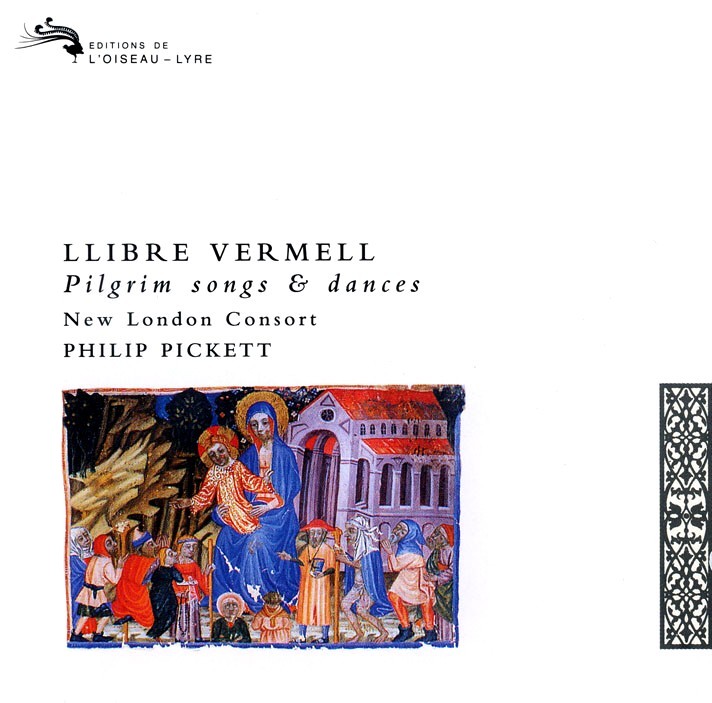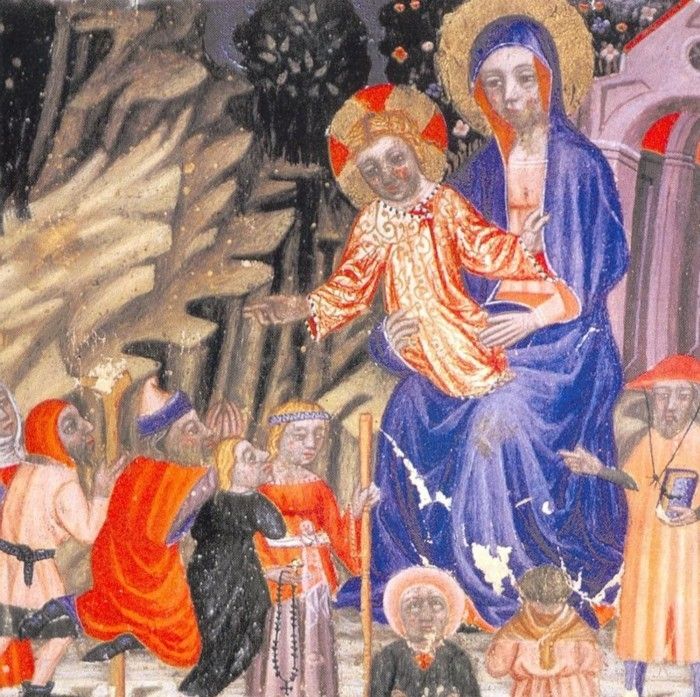The Llibre Vermell. Pilgrim Songs & Dances
New London Consort, Philip Pickett

medieval.org
L'Oiseau Lyre "Florilegium" 433 186-2
1992
Llibre Vermell of Monteserrat
Pilgrim songs and dances associated with the Shrine to tje Virgin at Montserrat
1. O Virgo Splendens (song) [7:18] LV 1
Catherine Bott · Tessa Bonner, sopranos
Catherine King, mezzo-soprano
Michael George · Stephen Charlesworth, baritones
Simon Grant, bass
Chorus
2. Stella Splendens (virelai-danse) [7:37] LV 2
Catherine Bott · Tessa Bonner, sopranos
Catherine King, mezzo-soprano
Michael George · Stephen Charlesworth, baritones
Simon Grant, bass
Chorus
2 lutes, 2 harps, 2 high fiddles, 2 low fiddles, 2 shawms, tabors
3. Laudemus Virginem (song) [5:17] LV 3
Catherine Bott · Tessa Bonner, sopranos
Catherine King, mezzo-soprano
Michael George · Stephen Charlesworth, baritones
Simon Grant, bass
Chorus
4. Mariam Matrem Virginem (virelai) [4:45] LV 8
Catherine Bott, soprano
Chorus
2 lutes, 2 harps, 2 high fiddles, 2 low fiddles, bells
5. Polorum Regina (virelai-danse) [2:35] LV 7
Chorus
6. Cuncti Simus Concanentes (virelai) [9:36] LV 6
Michael George, baritone
Chorus
guittern, 3 harps, 2 high fiddles, 2 low fiddles, 2 recorders, nakers, tabors
7. Splendens Ceptigera (song) [5:10] LV 4
Catherine Bott · Tessa Bonner, sopranos
Catherine King, mezzo-soprano
Michael George · Stephen Charlesworth, baritones
Simon Grant, bass
Chorus
8. Los Set Goyts (ballad-danse) [10:51] LV 5
Catherine Bott · Sara Stowe, sopranos
Chorus
guittern, 3 harps, 2 high fiddles, 2 low fiddles, dulcimer, bells
9. Imperayritz de la Ciutat Joyosa (motet) [10:40] LV 9
Andrew King, tenor
Chorus
2 lutes, 2 harps, 2 high fiddles, 2 low fiddles
10. Ad Mortem Festinamus (virelai) [5:59] LV 10
Chorus
guittern, 3 harps, 2 rebecs, 2 low fiddles, symphony, 2 recorders, xylophone, tabors
CHORUS
Catherine Bott · Tessa Bonner · Olive Simpson
Alison Wray · Sara Stowe · Catherine King
Kristine Szulik · Andrew King · Michael George
Stephen Charlesworth · Robert Evans
Mark Rowlinson · Simon Grant
Gittern - Tom Finucane
Lutes - Tom Finucane, Paula Chateauneuf
Gothic harps - Frances Kelly, Delyth Wynne, Hannelore Devaere
High fiddles - Paulo Beznosiuk, Giles Lewin
Low fiddles - Mark Levy, Susanna Pell
Rebecs - Pavlo Beznosiuk, Giles Lewin
Symphony - Philip Pickett
Recorders - William Lyons, Pamela Thorby
Shawms - Philip Pickett, Keith McGowan
Dulcimer - David Corkhill
Xylophone, Bells, Nakers, Tabors - Stephen Henderson

NEW LONDON CONSORT
Philip Pickett
Catherine Bott — soprano
Andrew King — tenor
Michael George — baritone
Simon Grant — bass
Producer: PETER WADLAND
Engineer: JONATAHN STOKES
Tape editor: DEBORAH ROGERS
This recording was monitored on B & W Loudspeakers
Recording location: Temple Church, London, November 1990
Cover: Illustration from the Llibre Vermell - Abadía, Biblioteca, Montserrat/Arxiu Más, Barcelona
Art Direction: DAVID SMART
© Ⓟ 1992 The Decca Record Company Limited, London
Gittern
Tom Finucane — g: Barber, London 1982 (after Hans Oth)
— d: Barber, London 1982 (after Hans Oth)
Lutes
Tom Finucane — Duncalf, Manchester 1978 (after late 14thC iconography)
Paula Chateauneuf — Barber, London 1982 (after early 15thC iconography)
Elyass, Damascus 1986 (Oud)
Gothic harps
Frances Kelly — Haycock, London, 1984 (after early 15thC iconography)
Delyth Wynne — Hobrough, Beauly 1990 (after early 15thC iconography)
Hannelore Devaere — Hobrough, Beauly 1989 (after early 15thC iconography)
High fiddles
Pavlo Beznosiuk — g: Shann, Brighton 1978 (after early 15thC iconography)
d: Gotschy, Berlin 1982 (after early 15thC iconography)
Giles Lewin — Laidlaw, Edinburgh 1979 (after early 15thC iconography)
Low fiddles
Mark Levy — Davies, London 1977 (after 15thC iconography)
Susanna Pell — Bridgewood, London 1989 (after 15thC iconography)
Pavlo Beznosiuk — Bisgood, London 1977 (after various folk originals)
Giles Lewin — Bisgood, London 1976 (after various folk originals)
Symphony
Philip Pickett — Ellis, Hereford 1977
Recorders
William Lyons — Moeck, Celle, 1984
Pamela Thorby — von Huene, Boston 1984
Shawms
Philip Pickett — Moeck, Celle 1976 (various originals)
Keith McGowan - Hanchet, Essen 1985 (Spanish original, Brussels)
Xylophone
Stephen Henderson — Leedy/Tuned Percussion, USA/London
Dulcimer
David Corkhill — Chinese, 1974
Bells
Stephen Henderson — Whitechapel Bell Foundry, London 1982
Nakers
Stephen Henderson — Williamson, Spalding 1975
Tabors
Stephen Henderson — Williamson, Spalding 1975
David Corkhill — Williamson, Spalding 1975

LLIBRE VERMELL OF MONTSERRAT
Europe
houses many shrines built in medieval times at the burial sites of
saints or apostles, or at places associated with miracles performed by
the Virgin Mary. In Spain, two such shrines were especially famous in
the Middle Ages —Santiago de Compostela in the north-west, where
pilgrims came from all over Europe to worship at the grave of St James (cf The New London Consort's recording Pilgrimage to Santiago,
L'Oiseau-lyre 433 148-2); and the monastery of Montserrat, near
Barcelona, where a more localised cult grew up around the chapel
dedicated to the Virgin.
The beautiful wooden carving of the
Virgin worshipped in Montserrat today dates from around 1200, but
hermits had lived on the mountain for centuries before that and a chapel
was established there from the 9th century. A monastery was founded on
the mountain in the 1020s by the famous Abbot Oliva of Ripon; a
Benedictine monastery equal in stature to St Martial of Limoges and St
Gallen in Switzerland. Ripoll, never isolated from other great European
centres of learning despite its geographical situation, became the most
important centre of Catalonia's religious culture, with its own special
areas and traditions of learning. The monks even developed a unique
system of musical notation.
The monastery at Montserrat, a branch
of Ripoll and thus from the beginning a small centre of learning,
quickly grew in fame and size until it became one of the great cultural
centres of Catalonia, finally achieving independence from Ripoll in 1409
and going on to outlive its founding house while continuing Ripoll's
finest intellectual traditions.
The monks of Montserrat were
noted for their intellectual and musical excellence; some attended
universities such as Paris and Bologna, some studied at the various
Benedictine schools, some in Barcelona or Montpellier; and there were a
number of well-educated clerical noblemen attached to the monastery.
Although these were not actual members of the monastic fraternity — each
representing a noble Catalonian family in the daily masses — their
close contact with the monks led to a constant and fruitful exchange of
learning and new ideas
By the end of the Middle Ages the monks
had assembled a distinguished library. Unfortunately this was largely
destroyed in 1811 during the Napoleonic wars. The most precious
surviving medieval manuscript in the Scriptorium at Montserrat is
undoubtedly the famous Ms. No.1, known as the Llibre Vermeil or Red Book
of Montserrat, from the colour of the late 19th century velvet which
covets the binding of the codex. The manuscript, completed in 1399,
originally contained about 172 double pages, or folios, of which 35 have
been lost.
Included in the Llibre Vermell are ten
musical works — possibly more originally — by a number of unknown
composers. They display considerable variety of musical and literary
style, and their purpose is explained in a note prefacing the first
song: 'Because the pilgrims to Montserrat sometimes have the desire to
sing and dance, both while holding night vigil in the church of the
Blessed Virgin, and also during the day on the church square, where only
decent and devout songs may be sung, so a number of suitable songs have
been written to satisfy their need. These should be made use of with
respect and moderation, without disturbing those who wish to continue
their prayers and religious meditations.' The pilgrims are further
exhorted to avoid frivolous songs and lascivious dances both during
their journey to the shrine and on the way home!
The musical compositions of the Llibre Vermell are certainly not the work of only one composer. O Virgo splendens,
the first song in the manuscript, is written in a kind of plainsong
notation — possibly the piece represents an early, specifically local
style — while the rest display direct links with Ars Nova style
and notation. This is interesting as these techniques of composition
would have been known in Catalonia only by professional musicians.
Perhaps the pieces in pure Ars Nova style were written to honour
the Virgin of Montserrat by musicians from the Aragonese court. The
rest, which show a number of very individual features, may have been
written by the monks themselves.
It could be that the
well-travelled scholars of Montserrat became acquainted with a variety
of foreign song styles and compositional techniques and brought their
knowledge home to the monastery, where they developed their own very
individual style of composition —somehow managing to belong to the Ars Nova tradition while displaying a unique and noble simplicity, a direct and sometimes earthy naivety closely related to folk song.
Or perhaps there is another, very simple explanation; the last song in the manuscript, Ad mortem festinamus, appears to make a virelai out of a version of another Latin song, Scribere proposui, which survives in a number of other sources. Perhaps most of the music of the Llibre Vermell
repertory existed with other words as folk song, virelai, ballade,
rondellus, conductus and motet before the monks of Montserrat
substituted their own newly-composed and more suitably pious texts.
After all, we know that the first Christmas songs sung in church were
often dance songs with refrains known as caroles, the texts
reminders of old pagan customs associated with the winter solstice. Many
of these texts were deemed lascivious and unsuitable, and so had to be
replaced by more pious words. Thus the new Christmas refrain songs
became known as carols.
There are other, even more relevant, examples of similar contrafacta.
In the early 14th century Richard Ledrede, Bishop of Ossory compiled a
moralising anthology of new songs called The Red Book (!) of Ossory. In
the preface we read 'the Bishop of Ossory has made these songs for the
vicars of the cathedral, for the priests and clerks, to be sung on
important holidays and at times of recreation so that their throats and
mouths, consecrated to God, may not be polluted by songs associated with
lewd and worldly revelry. As they are trained singers they should
provide themselves with suitable tunes the words require.'
The fact that the 10 songs of the Llibre Vermell were copied into the manuscript at all indicates that they had already proved popular with pilgrims. Three of them, Cuncti simus concanentes, Los set goyts and Ad mortem festinamus were intended as dance songs, for the rubrics state clearly that they should be performed ad trepudium rotundum or a ball redon - as circle dances; three are mesmeric mantra-like canons, associated with the French chace and rondellus; and at least one, Polorum regina, was still alive as a folk song in the 16th century.
Philip Pickett




